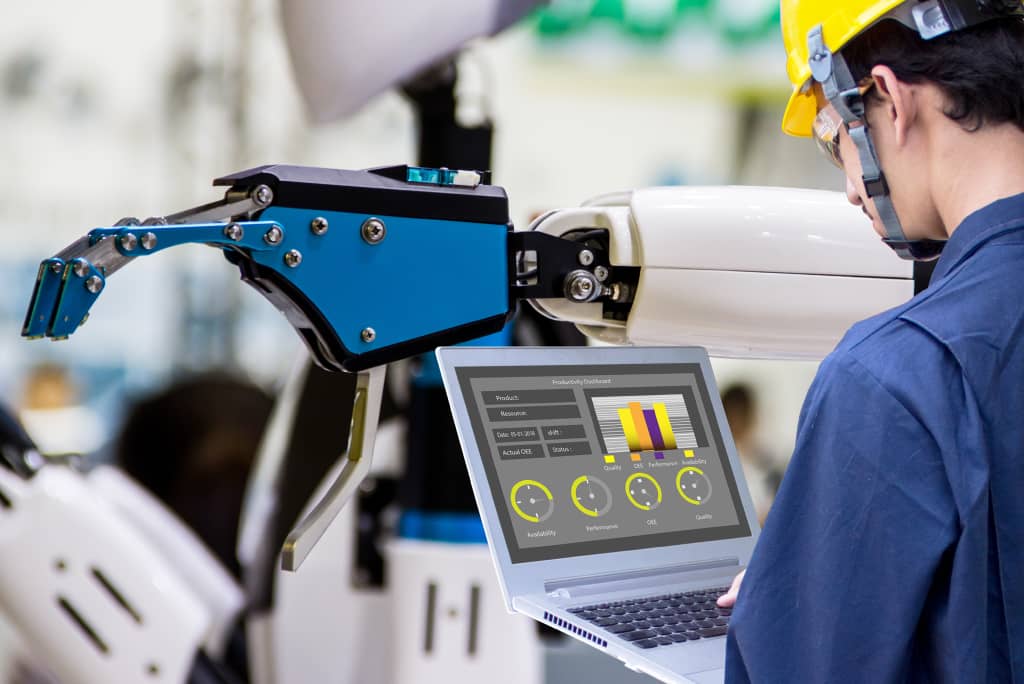RECENT POSTS

What Is SCADA and How Does It Work? What to Know Before Hiring SCADA Integrators
What Is SCADA and How Does It Work?
A SCADA system, part of the broader category of industrial control systems (ICS), facilitates real-time monitoring and control of industrial processes. By collecting data from remote sensors, communicating analytical insights to field equipment, and enabling informed decision-making, SCADA systems optimize productivity, cut costs, and enhance safety in industrial operations. These systems aggregate data from various industrial hardware, empowering users to identify issues, make efficient decisions, and implement precise controls across diverse industrial processes.
There are many acronyms associated with industrial control systems, so it’s important to know the difference between PLC, SCADA, and DCS, among others. Here are some of the ICS, PLC, and SCADA basics and how these systems work together:
Data Acquisition
SCADA systems begin with data acquisition from field sites or connected machines, employing sensors, transmitters, and gauges to measure physical parameters. The system devices convert these measurements into electrical signals, which are then transmitted to remote terminal units (RTUs) or programmable logic controllers (PLCs).
Transmission to Local Controllers
RTUs and PLCs have microprocessors converting sensor signals into digital data. These controllers can work bidirectionally to issue basic control commands to local equipment. Comparing SCADA vs. PLCs, it is the PLC that handles the commands, but it is the SCADA software that initiates any changes.
Central Aggregation and Analysis
RTUs collect data from multiple field sites and transmit it to a central computer server, known as the master terminal unit (MTU). The MTU stores field data in a historical database and runs SCADA system software for processing, analysis, and visualization.
Data Visualization via HMIs
Operators monitor system status through a human-machine interface (HMI), displaying data in graphs, charts, schematics, trends, and other visuals. Users can interact with different site representations through the HMI.
Control Capabilities
When sensors detect critical parameters, SCADA activates alarms at HMIs to alert personnel. Operators investigate issues using visuals and time-series data. HMIs enable remote control of equipment from the central SCADA workstation.
PLC and SCADA programming work in concert to effect changes. In some applications, control changes happen automatically when pre-configured thresholds are detected.
Connectivity with Networks
The SCADA MTU provides plant data access via the corporate intranet, facilitating analysis, optimization of setpoints, report creation, maintenance planning, and more. It interfaces with plant control networks and equipment like distributed control systems (DCSs).
Alerting and Alarm Management
ICS SCADA systems feature alarm management to rapidly notify personnel of issues, based on pre-configured thresholds. Monitoring field data for values exceeding defined limits, the system triggers alarms for specific individuals in response to out-of-range conditions in variables such as temperature, fuel levels, or pressure.
The Benefits of ICS SCADA Systems
There are significant benefits associated with a well-designed and integrated ICS SCADA system.
1. Scalability
SCADA systems are inherently scalable, allowing components to be seamlessly added or upgraded to accommodate evolving information and control requirements. This scalability ensures that the system can grow in tandem with the expanding needs of the industrial processes it oversees, providing a future-proof solution.
2. Flexibility
One of the standout features of SCADA lies in its remarkable flexibility. This adaptability enables the system to be customized for a broad portfolio of industry applications. Whether managing manufacturing processes, utility networks, or critical infrastructure, SCADA’s flexible design ensures it can be tailored to the specific demands of various sectors.
3. Cost Savings
SCADA systems offer a cost-effective solution through a strategic blend of commercial off-the-shelf (COTS) components and custom-developed elements. By leveraging existing commercial technologies while incorporating custom solutions where necessary, organizations can realize significant cost savings in both deployment and maintenance.
4. Reliability
Built with redundancy in mind, ICS SCADA systems are engineered to prevent single-point failures. Redundant components and failover mechanisms ensure continuous operation even in the face of hardware or software issues. This heightened reliability is critical for maintaining uninterrupted industrial processes.
5. Enhanced Monitoring and Control
At its core, SCADA excels in optimizing industrial automation through enhanced monitoring and control capabilities. The system provides real-time insights into industrial processes, enabling operators to make informed decisions promptly. This heightened visibility and control contribute to increased operational efficiency and reduced downtime, resulting in overall improved industrial performance.
Managing SCADA Security
Given the prevalence of SCADA systems in critical infrastructure, prioritizing SCADA security is imperative. Cyberattacks on both IT and OT are increasing as cybercriminals and nation-states target industrial control systems. One cybersecurity company reported that ICS attacks were growing at a record pace in 2023, finding malware or malicious files on more than a third of the systems they analyzed. Another company characterized two-thirds of such attacks as critical or high-threat—with no patch or remediation available.
Joint Warning on SCADA Cyber Security
Recognizing the continuing nature of cyberattacks on ICS and SCADA systems, a rare joint alert was issued by the Department of Energy, the National Security Agency, the FBI, and the Cybersecurity and Infrastructure Security Agency.
The agencies reported that hackers are using custom-made tools for ICS/SCADA devices, enabling them to scan for compromises and take control of devices and operational technology networks. Many attacks have occurred through unprotected endpoints where hackers accessed networks, elevated privileges, and disrupted critical functions.
Recent attacks include:
- A Google-owned facility launched multiple attacks over several months where threat actors were able to switch off substations and then erase their tracks.
- A November 2023 attack targeted Israeli-made PLCs commonly used worldwide.
- Multiple attacks on UK and U.S. water systems, including a Florida system where attackers increased sodium hydroxide to deadly levels.
The modular architecture of ICS/SCADA systems, coupled with an ever-expanding number of endpoints, provides cybercriminals with opportunities for highly automated exploits, emphasizing the need for heightened vigilance.
Implementing Robust SCADA Security Measures
The joint alert recommends operators take immediate action to protect ICS SCADA devices already in place, including:
- Isolate ICS/SCADA Systems: Implement strong perimeter controls for network isolation.
- Enforce Multifactor Authentication: Mandate multifactor authentication for remote ICS access.
- Cyber Incident Response: Maintain and exercise a cyber incident response plan.
- Regular Password Changes: Change passwords regularly for enhanced security.
- OPC UA Security: Configure OPC UA security with authentication and secure key storage.
- Offline Backups and Integrity Checks: Keep offline backups and conduct integrity checks.
- Limited Network Connections: Restrict ICS/SCADA network connections.
- Management System Protection: Configure Device Guard, Credential Guard, and HVCI for robust protection.
- Log Collection and Retention: Implement robust log collection and retention.
- Continuous OT Monitoring: Utilize continuous OT monitoring for threat alerts.
- Application Control: Install applications only when necessary.
- Symptoms of Denial of Service: Investigate signs of denial of service promptly.
- Monitoring for Unusual Activity: Monitor systems for abnormal traffic and use CISA’s ICSNPP for enhanced visibility.
One of the reasons cybersecurity has become a serious issue is that many legacy SCADA systems have been in place for more than a decade. Such systems were not designed to overcome modern hacking tools. Most systems were not built with privacy by design principles.
Reliable industrial automation solutions are critical for improving productivity, lowering expenses, and optimizing workflows. However, cybersecurity precautions need to be integral and continually supervised to ensure operational integrity. Pacific Blue Engineering designs, constructs, and incorporates secure, unified oversight and regulation for a SCADA framework, with an intense focus on securing critical functions.
Finding the Best SCADA Integrator for Your Industrial Application
What makes a good SCADA Company? Here are some of the key items you will want to consider.
Domain Expertise
Look for a SCADA integrator with extensive expertise in SCADA hardware, software, and integration strategies. Ensure they have a proven track record of designing, installing, programming, and maintaining major SCADA platforms relevant to your project.
ICS SCADA integrators should:
- Have deep experience with similar SCADA installations: Seek those who have successfully executed projects comparable to yours, demonstrating a nuanced understanding of specific challenges and solutions.
- Develop customized solutions using innovative approaches: Prioritize integrators with a creative approach to problem-solving, showcasing their ability to craft bespoke solutions that go beyond standard applications.
- Be well-versed in current SCADA technology but committed to emerging advancements: Choose integrators who balance a strong foundation in current SCADA technology with a proactive commitment to staying abreast of emerging trends and technological advancements.
Industry Understanding
Confirm that the integrator has a history of tailoring SCADA solutions to specific industry needs, ensuring that their expertise goes beyond general knowledge to address industry-specific nuances.
Look for SCADA integrators that have:
- Tailored solutions: Seek evidence of their capability to tailor solutions to the unique needs of your industry, ensuring the integration aligns with specific operational requirements.
- Regulatory compliance: Check for a track record of adherence to industry regulations, emphasizing the integrator’s commitment to compliance and understanding of the legal landscape within your sector.
- Awareness of industry challenges: Assess the integrator’s understanding of industry challenges and how they have successfully navigated similar obstacles in the past.
Technical Skills and Control Engineering Proficiency
Evaluate the technical capabilities of SCADA technicians, focusing on diverse skills such as SCADA application software configuration, PLC and DCS configuration, HMI visualization, database architecture, networking, cybersecurity, middleware, alarm management, reporting, data analytics, monitoring, and diagnostics.
The best SCADA integration firms will have:
- Interoperability expertise: Seek evidence of successful integration with a variety of technologies, showcasing the integrator’s ability to ensure smooth interoperability within complex systems.
- Extensive in-house capabilities: Verify that the integrator has a robust team with diverse skills in-house, minimizing reliance on external parties for critical deliverables and ensuring better control over project timelines.
- Track record of troubleshooting: Assess the integrator’s track record in troubleshooting and resolving technical issues efficiently, demonstrating their ability to handle unforeseen challenges during project execution.
Documented project management strategies
Choose a SCADA integrator with a documented project management strategy, emphasizing meticulous planning from understanding your needs to architecting a custom solution.
Probe for:
- Client collaboration: Ensure the project management strategy includes clear mechanisms for client involvement, fostering collaboration throughout the project lifecycle.
- Risk mitigation plan: Look for a documented risk mitigation plan, demonstrating the integrator’s proactive approach to identifying and addressing potential project risks before they escalate.
- Post-implementation support: Verify that the project management strategy includes a robust post-implementation support plan, ensuring ongoing assistance and troubleshooting beyond the deployment phase.
Cultural Fit and Integrity
Finding SCADA technicians that are compatible with the way you work and are a cultural fit is critically important, but often overlooked.
Look for SCADA integrators that put your organizational needs first and act with integrity. Check for:
- Communication style alignment: Assess the integrator’s communication style to ensure it aligns with your organization’s preferences, promoting effective collaboration.
- Commitment to deadlines: Inquire about the integrator’s commitment to meeting deadlines and their track record in delivering projects on time, showcasing reliability.
- Cultural compatibility: Consider conducting a cultural compatibility assessment to ensure that the integrator’s values and work ethic align with your organization’s culture, fostering a positive working relationship.
Choose Pacific Blue Engineering
Pacific Blue Engineering holds itself to the highest industry standards, taking the time to understand your goals and requirements to design custom ICS SCADA solutions that fit your unique workflow and management style.
Rather than simply integrating pre-packaged software, Pacific Blue Engineering’s SCADA technicians create a tailored architecture that works with your unique technical infrastructure. Our responsive teams blend control systems engineering, operational technology cybersecurity, and forward-compatible IIoT solutions designed for your success.
Contact Pacific Blue Engineering for a consultation or call us at (657) 201-8603.
Frequently Asked Questions
What are Some SCADA System Examples?
Some common examples of SCADA systems include those used in energy systems (power plants, electrical grids), water management systems (dams, pipelines), transportation systems (traffic signals, rail systems), and industrial processes (assembly lines, refineries).
What are the Three Main Components of SCADA?
The three main components of a SCADA system are:
- Field Instruments/Sensors: Devices that measure data or the status of equipment in the field, like flow meters or temperature sensors.
- SCADA/MTU: The central supervisor computer system that collects, processes, displays, and logs data from the field instruments.
- Communication Networks: The networks, including hardware like routers, switches, and radio equipment, that connect the field instruments to the SCADA/MTU system.
What Are the Three Main Functions of SCADA Systems?
The three core functions of SCADA systems are:
- Data Acquisition: Collecting data from sensors and instruments in real-time.
- Supervisory Control: Remotely controlling equipment and processes like opening valves or restarting systems.
- Data Presentation/Logging: Presenting operational data to human operators, and logging the data for analysis and supervision.
What Makes a Good SCADA Company?
A good SCADA company can provide reliable and secure SCADA solutions that meet the specific needs of industries by applying extensive control engineering techniques, including strong cybersecurity measures and effective real-time monitoring capabilities.
Contact Pacific Blue Engineering for a consultation or call us at (657) 201-8603.
similar posts
Certifications
Contact Us
Telephone:
Corporate Office “The Shop”
Pacific Blue Engineering, LLC
2880 Orange Ave
Long Beach, CA 90755
© All contents copyright © 2023 by Pacific Blue Engineering













